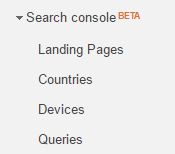Integration of Search Console in Google Analytics
In May Google announced that Google Search Console could be deeper integrated with Google Analytics but what exactly does this mean, what insights will it give and how do you enable this feature?
Search Console is a free service offered by Google that helps website owners and marketers manage and monitor how they appear in Google organic search results. Google Analytics focuses on the data that the traffic creates once it has reached your website.
Search Console allows you to analyse a websites performance in Google search. It shows you data on Total Impressions, Clicks, CTR and Average Position for keyword phrases that the website is ranking for. These phrases may not have been identified as phrases to target but could still be driving significant traffic to your website.
Anyone wishing to analyse, understand and improve organic traffic from Google will be interested in this update. Essentially the Search Engine Optimisation reports in Analytics have been replaced with a Search Console section. The new reports combine Search Console and Analytics metrics, allowing you see the data for organic search traffic from both in one report.
What do the reports show?
The reports pull in the following data from Search Console – Impressions, Clicks, CTR and Average Position and the following from Analytics – Sessions, Bounce Rate, Pages/Sessions, Goals/Ecommerce, Conversion Rate, Transactions and Revenue. For the first time this data appears side by side.
There are 4 new reports – Landing Pages, Countries, Devices and Queries which are found in Analytics under Acquisition.
Landing Pages Report
Each landing page appears as a separate row within the report and allows you to see at glance how the organic search traffic performs for that specific page, how visitors reached the website and what they did when they go there.
What does it all mean?
It means greater actionable insight into the performance of a website for organic search results. The landing page report joins acquisition data with behaviour and conversion data. You can therefore see at landing page level how many clicks, the average position, bounce rate and conversion rate that page gets.
Let’s say for example you had an optimised landing page for pink girls bikes – mymadeupsite.co.uk/pink-girls-bikes with a form set up as a goal, you would be able to see the keywords that had driven traffic to that landing page and at a rolled up level what happened to the visitors when they were on the site. Did they bounce? Did they navigate further into the website? Did they convert? It creates insights which creates actions to better optimise the landing page.
Devices Report
This report allows you to deep dive into the devices – desktop, mobile and tablet and how they arrive and navigate your website, You can see at a glance the comparison between Click Through Rates (CTRs) and Goal Conversions of desktop, mobile and tablet and the landing pages and search queries behind them. This is incredibly valuable data. Back to Pink Girls Bikes you might see that the conversion (remember a form was setup as a goal) is better on desktop and mobile than a tablet. This might mean you review how the form looks or is setup for a tablet user to help improve that conversion rate. You might also notice that some landing pages perform better on mobile than desktop and therefore may look at why that is.
This all sounds great but how do I enable it?
You will need to link your Search Console and Analytics properties through Analytics.
Step 1: Navigate in Analytics to Acquisition > Search Console where there are 4 reports – landing pages, countries, devices and queries. Select one of them and select “Set up Search Console data sharing”:
Step 2: Select “Property Settings”
Step 3: Scroll to the bottom of the page and select “Adjust Search Console”
Step 4: Select the site to be linked, Save and Select “add a site to Search Console”
Step 6: Start gaining valuable insights
Summary
In summary integrating Search Console with Analytics will enable a deeper understanding of search data from beginning to end and enable actionable insights such as:
- Understanding the search queries that are ranking well for each organic landing page rather than the website as whole
- Examining how desktop, mobile and tablet users find and interact with the website
- Improve landing pages in two specific ways:
- Improving the landing pages where many users are arriving at the landing page (high click through rate and impressions) but not spending time on the website by navigating through the site (pages/sessions), immediately exiting the website (bounce rate) or not converting to a goal (eg: filling in a contact form).
- Improving the search presence of landing pages where the users are navigating further through the website and converting but have a low click through rate.
All of these insights should help build a better user experience and in Google’s eyes a better search experience too.



